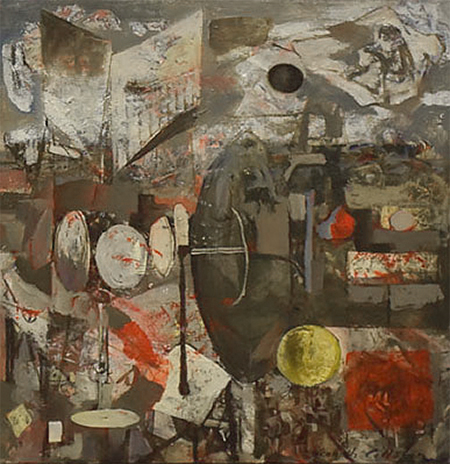
Continuing through February 13, 2016
The fate of the Northwest School and its “Big Four” artists — Mark Tobey, Morris Graves, Guy Irving Anderson and Kenneth Callahan — has fluctuated depending upon the continued (or flagging) interest of critics, curators, collectors and art dealers. Callahan (1906-1986) has fared better than Anderson (largely forgotten), but not as well as Graves or Tobey. “Kenneth Callahan: Early Works” goes a long way toward reminding reviewers how substantial and varied his achievement was.
During their respective lifetimes, Callahan appeared to be getting ahead faster, sooner, and for a longer period of time, than the others. His blend of ghostly spirituality, vigorous male figuration, and lusty, gestural brushwork put him in the first Whitney Biennial in 1933 (and kept him there until 1960), leading to nearly annual shows in New York from 1946 to 2001 which guaranteed him national and international exposure from museums and galleries as far flung as Belgium, Germany and Japan, as well as Arkansas, Arizona and Virginia back in the U.S.
John Braseth spent over a year assembling this fairly comprehensive survey, largely from the artist’s estate, but also drawn from prestigious private collections. Some of the works have not been seen in 50 years; others have never been exhibited before. His choices belie the artist’s statement to me that “all my best work ended up in New York.” While it is true that, for example, the Metropolitan Museum of Art has over two dozen Callahans (shown in 1953), the new selection of 55 oils, temperas and ink-brush paintings are nearly all museum quality.
Beginning with the earliest works, such as “Molten World” (1950) and “Family” (1951), all of Callahan’s key themes or motifs are here. Nature; birds, horses and insects; wind and water currents; and the human figure all dance in and out of the dynamic, colorful compositions. Callahan added art history and myth as driving influences. It is easy to see everything in the shadows of Chinese Sung dynasty scroll painting (“North Lake,” 1950), Michelangelo (“Horse and Riders,” 1960) and early and late abstract expressionism (“Volatile Tide,” 1972), especially Jackson Pollock, whom Callahan embraced as a major influence, along with the earlier Albert Pinkham Ryder.
Nineteen sixty-eight was a watershed year with such smaller, condensed masterpieces as “Carnival,” “Floating World IV,” “Contemplation” and “Boat Basin” glowing with their gem-like colors and areas of interlocking space that push them close to cubism, reminding us of the artist’s considerable formal strengths.
Spread out with little concern for chronology, the canvases and works on paper and wooden panel go some distance to repudiating the critical furor over his late-period works after his move to a beach cabin in Long Beach, Washington in 1964. The exuberant, airy abstractions of orange, yellow, blue and brown on white backgrounds were a disappointment to some writers comfortable with Callahan, the dark prophet, rather than his newfound freedom at the coast. Forty years on, “Figures Ascending” (1976), “Summer Currents,” “Wave Form,” and “Tidal Surf” (all 1970) look fresher than ever, granting the 64-year-old a welcome breathing space after the gloomy, apocalyptic temperas of the 1930s and 1940s.
Because they stray far from the Big Four aesthetic — universal myth, darker color, Asian technique — Callahan’s late period works are still contested and underrated, but there are plenty of midcentury treasures to appease those who prefer his “mystic” side. “Estuary” (1960), “Prophet and the Rock” (1950s), and “Requiem” (1953) are classic Callahans with the latter employing extraordinary, unexpected shades of purple and yellow.
Due to his stature while he was alive and because he was the only one of the group to also work as a professional museum curator and, later, art critic for the Seattle Times, Callahan deserves closer scrutiny. He was a major cultural figure in a minor American backwater, Seattle, for decades. Though there is nothing from the first half of his career on view, what is on the walls gives viewers a chance to see how one of the group evolved after 1955, the year one curator set as the end of their golden age as a regional force to be reckoned with, one that could not be, and never was, ignored by New York at the time.
